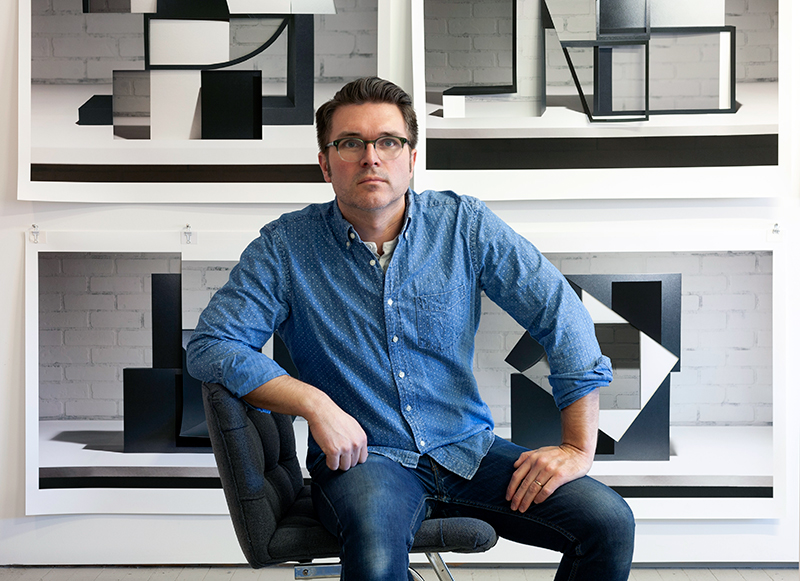
Kansas City-based Caleb Taylor has been a painter, a founding member and curator of an artist-run gallery, a furniture designer, a potter, an art handler, and an art teacher—currently at the Metropolitan Community College, Longview campus. His art touches on painting, collage, photography, and sculpture. For Taylor, making art is haptic (based on the sense of touch), abstract, non-literal, and personal. His work is represented locally by Haw Contemporary and is included in the public collections of Nerman Museum of Contemporary Art, KU Medical Center, and the Polsinelli Law Firm.
He received his MFA in Painting from Montana State University-Bozeman (2008) and his BFA from Northwest Missouri State University (2004) in Ceramics and Painting.
Taylor is a founding member of PLUG Projects, a curatorial collaboration with the shared goal of engaging artists and the public at large by exhibiting challenging new work, initiating critical dialogue, and expanding connections of voices in Kansas City as part of a wider, national network of creative practitioners. During his tenure with PLUG (2011-2016), he collaborated to curate over 35 exhibitions and more than 100 public programs ranging from rap battles, interpretive sound performances, installations taking over vacated shopping malls, artist book fairs, panel discussions, and collaborative events joining confectionery and dance. PLUG is a recipient of a 2011 Rocket Grant from the Andy Warhol Foundation, Spencer Museum of Art, and Charlotte Street Foundation.
In 2024, Taylor is “prototyping a collection of bespoke home accessories in collaboration with architect Christopher Spaw for George Terbovich,” he says. “This line of white-oak furniture is articulately handmade for designed lifestyles and will debut in international showrooms in 2024 as Moveable Feast.”
How does approaching art from different disciplines enrich your career?
Working as a crate builder and furniture designer has given me the skills and experience to expand how I think about fabrication and materiality. Art handling connected me to artists and museum programs where I began understanding installation as the greatest instrument in my practice, and teaching shows me how to lead a life with curiosity. My time with PLUG Projects continues to influence me today—the dialogues, introductions to new artists, and the collaborative spirit we had encouraged with new media and ideas in my studio. The artists we worked with exposed me to a scale of thinking and working I hadn’t encountered previously, and today I continue curating exhibitions to interact with artists, to build connections between ideas and people, and to enrich my practice.
How does a new work start for you?
New work begins with ideas carried over from previous work—being in the studio is how I discover future directions. Collage fragments may become a silhouette for new sculptures, photograms become the composition of a new painting, photographs become the matrix for new wallpaper installations. The built landscape has a significant influence on my work, and it’s a daily source for form, structure, and color. Sketchbook studies, thumbnails, and architectural models are ways to initiate processes that will evolve with time, knowing final works are rarely reminiscent of these beginning steps.
How did you get interested in art? Do your children like to paint with Dad, or do you think they’ll grow up to be accountants or soccer players?
I come from a family that is both analytical and creative. My father, sister, and brother are engineers, and my mother owned and operated a wallcovering and painting business for 30 years. From her I learned the value of observation, how to design a room, and to appreciate the beauty in everyday experiences. My parents emphasized the value of working with your hands and building the life you desire through labor and collaboration. They built my childhood homes around their family, and I have many pictures from my youth on these construction sites that were my earliest exposure to geometric design and construction. When I bought and renovated my house in the Northland, my work became more architectural and constructed, and I began seeing the influence of my father. My wife is an elementary art educator in Liberty, so my son and daughter come by it honestly and are constantly drawing books, creating costumes, writing and illustrating comic books, telling jokes. With my upcoming residency at Studios Inc., they will have space to work alongside me unlike ever before, and I’m looking forward to having their energy in my studio. Today, they both want to be artists, and it is exciting to imagine what their futures hold. I’m looking forward to reading the books they write, experiencing the buildings they will design, attending the lectures they will give, and hopefully being their future collaborator.
What are your favorite things to do as a family in Kansas City?
We enjoy our weekend trips to the Kansas City public libraries, visits to Union Station and Science City, the KC Zoo—especially with the addition of the aquarium—Saturday morning sketchbook sessions at the Nelson-Atkins, and rolling a few games at Diamond Bowl in Independence.


